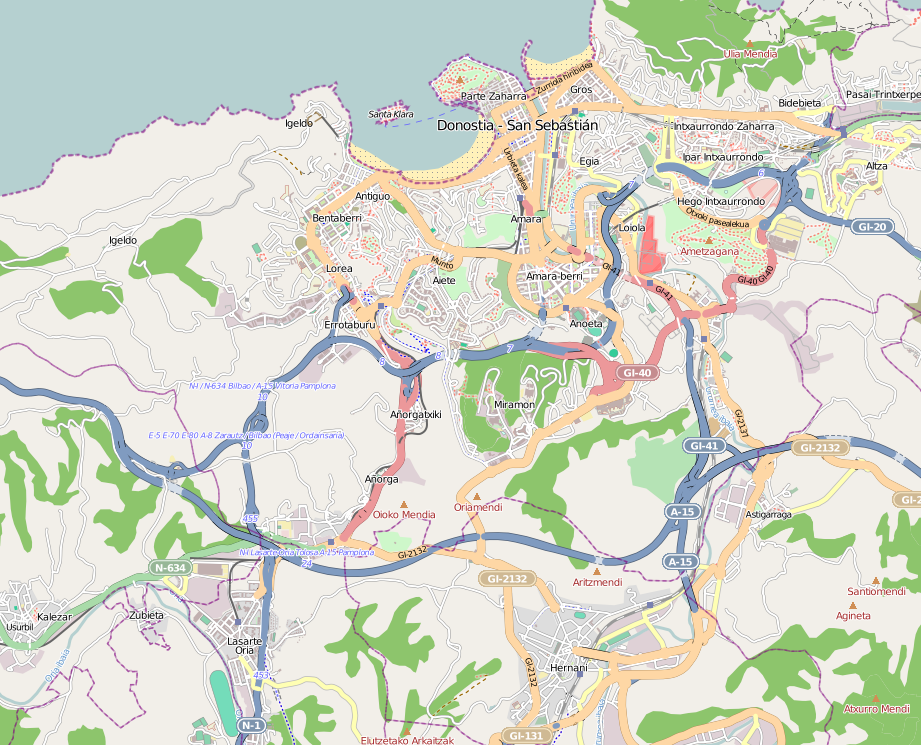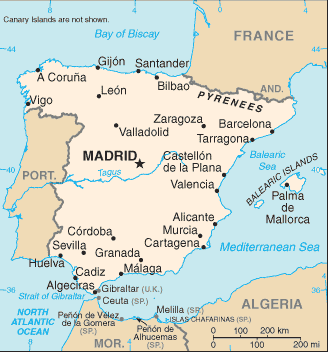|
Time In Spain
Spain has two time zones. Spain mainly uses CET (UTC+01:00) in Peninsular Spain, Balearic Islands, Ceuta, and Melilla. In the Canary Islands, the time zone is WET (UTC±00:00). In both territories, Daylight saving time is observed during summer months, meaning that mainland Spain uses CEST (UTC+02:00), whilst the Canary Islands uses WEST (UTC+01:00) between March and October. Spain used GMT (UTC±00:00) before the Second World War (except for the Canary Islands which used UTC−01:00 before this date). However, the time zone was changed to Central European Time in 1940 and has remained so since then, meaning that no parts of Spain use the "natural" time zone which Spain's geographic position under the coordinated time zone system would indicate. For example in A Coruña in the northwest of Spain, in the solstices, it experiences in summer sunrise at 6:53 am and sunset at 10:19 pm while it should respectively be 5:53 am and 9:19 pm, and in winter it experiences sunrise at 9:03 a ... [...More Info...] [...Related Items...] OR: [Wikipedia] [Google] [Baidu] |
San Sebastián
San Sebastián, officially known by the bilingual name Donostia / San Sebastián (, ), is a city and municipality located in the Basque Autonomous Community, Spain. It lies on the coast of the Bay of Biscay, from the France–Spain border. The capital city of the province of Gipuzkoa, the municipality's population is 188,102 as of 2021, with its metropolitan area reaching 436,500 in 2010. Locals call themselves ''donostiarra'' (singular) in Basque, also using this term when speaking in Spanish. It is also a part of Basque Eurocity Bayonne-San Sebastián. The economic activities in the city are dominated by the service sector, with an emphasis on commerce and tourism, as San Sebastián has long been well-known as a tourist destination. Despite the city's relatively small size, events such as the San Sebastián International Film Festival and the San Sebastian Jazz Festival have given it an international dimension. San Sebastián, along with Wrocław, Poland, was the Eur ... [...More Info...] [...Related Items...] OR: [Wikipedia] [Google] [Baidu] |
Timezones2008 UTC-1
International: * List of time zones by country – sorted by number of current time zones in the world * List of UTC offsets – current UTC offsets * List of time zone abbreviations – abbreviations * List of tz database time zones – zones used by many computer systems as defined by IANA * List of military time zones The military time zones are a standardized, uniform set of time zones for expressing time across different regions of the world, named after the NATO phonetic alphabet. The Zulu time zone (Z) is equivalent to Coordinated Universal Time (UTC) and i ... Country-specific: * List of time zones by U.S. state See also * :Time by country * :Time by continent {{DEFAULTSORT:Time zones ... [...More Info...] [...Related Items...] OR: [Wikipedia] [Google] [Baidu] |
Radio Nacional De España
Radio Nacional de España (acronym RNE, branded rne, "National Radio of Spain") is the national Government-owned corporation, state-owned public service broadcasting, public service radio broadcaster in Spain. RNE is the radio division and Televisión Española (TVE) is the television division of RTVE, Radiotelevisión Española (RTVE), the public corporation which has the overall responsibility for the national broadcasting public services under a Congress of Deputies, Parliament-appointed Chair of RTVE, president who, in addition to being answerable to a board of directors, reports to an all-party committee of the national parliament, as provided for in the Public Radio and Television Law of 2006. RNE launched its Radio Nacional (Spanish radio station), first station on 19 January 1937. It is currently headquartered at Casa de la Radio at Prado del Rey (studios), Prado del Rey in Pozuelo de Alarcón. Origins of RNE RNE officially came into existence in Salamanca on 19 Janu ... [...More Info...] [...Related Items...] OR: [Wikipedia] [Google] [Baidu] |
Television Broadcaster
A television broadcaster or television network is a telecommunications network for the distribution of television show, television content, where a central operation provides programming to many television stations, pay television providers or, in the United States, Multichannel television in the United States, multichannel video programming distributors. Until the mid-1980s, broadcast programming on television in most countries of the world was dominated by a small number of broadcast network, terrestrial networks. Many early television networks such as the BBC, Canadian Broadcasting Corporation, CBC, PBS, People's Television Network, PTV, NBC or ABC American Broadcasting Company, in the US and Australian Broadcasting Corporation, in Australia evolved from earlier radio networks. Overview In countries where most networks broadcast identical, centrally originated content to all of their stations, and where most individual television transmitters therefore operate only as large ... [...More Info...] [...Related Items...] OR: [Wikipedia] [Google] [Baidu] |
Radio Broadcasting
Radio broadcasting is the broadcasting of audio signal, audio (sound), sometimes with related metadata, by radio waves to radio receivers belonging to a public audience. In terrestrial radio broadcasting the radio waves are broadcast by a land-based radio station, while in ''satellite radio'' the radio waves are broadcast by a satellite in Earth orbit. To receive the content the listener must have a Radio receiver, broadcast radio receiver (''radio''). Stations are often affiliated with a radio network that provides content in a common radio format, either in broadcast syndication or simulcast, or both. The code, encoding of a radio broadcast depends on whether it uses an analog signal, analog or digital signal. Analog radio broadcasts use one of two types of radio wave modulation: amplitude modulation for AM radio, or frequency modulation for FM radio. Newer, digital radio stations transmit in several different digital audio standards, such as DAB (Digital Audio Broadcas ... [...More Info...] [...Related Items...] OR: [Wikipedia] [Google] [Baidu] |
University Of Las Palmas De Gran Canaria
The University of Las Palmas de Gran Canaria, also known as the ULPGC (''Spanish'' Universidad de Las Palmas de Gran Canaria) is a Spanish public university located in Las Palmas de Gran Canaria, the capital city of Gran Canaria island. It is the university with the most students in the Canary Islands. It consists of five campuses: four in Gran Canaria (Tafira, Obelisco, San Cristóbal and Montaña Cardones) and one in the island of Lanzarote, with Tafira being the largest. The University was created in 1989 after many years of petitions from the people of Gran Canaria. The university was incorporated through the University Reorganization Act of 1989. ULPGC was created as the aggregation of the teaching centres of former "Universidad Politécnica de Canarias", focused on engineering (industrial, civil, electronics and computer), and the centres from neighbouring Universidad de La Laguna that were located in Las Palmas province. This University of Las Palmas de Gran Canaria has a ... [...More Info...] [...Related Items...] OR: [Wikipedia] [Google] [Baidu] |
Iberian Peninsula
The Iberian Peninsula ( ), also known as Iberia, is a peninsula in south-western Europe. Mostly separated from the rest of the European landmass by the Pyrenees, it includes the territories of peninsular Spain and Continental Portugal, comprising most of the region, as well as the tiny adjuncts of Andorra, Gibraltar, and, pursuant to the traditional definition of the Pyrenees as the peninsula's northeastern boundary, a small part of France. With an area of approximately , and a population of roughly 53 million, it is the second-largest European peninsula by area, after the Scandinavian Peninsula. Etymology The Iberian Peninsula has always been associated with the River Ebro (Ibēros in ancient Greek and Ibērus or Hibērus in Latin). The association was so well known it was hardly necessary to state; for example, Ibēria was the country "this side of the Ibērus" in Strabo. Pliny the Elder, Pliny goes so far as to assert that the Greeks had called "the whole of the peninsula" Hi ... [...More Info...] [...Related Items...] OR: [Wikipedia] [Google] [Baidu] |
Summer
Summer or summertime is the hottest and brightest of the four temperate seasons, occurring after spring and before autumn. At or centred on the summer solstice, daylight hours are the longest and darkness hours are the shortest, with day length decreasing as the season progresses after the solstice. The earliest sunrises and latest sunsets also occur near the date of the solstice. The date of the beginning of summer varies according to definition, climate, tradition, and culture. When it is summer in the Northern Hemisphere, it is winter in the Southern Hemisphere, and vice versa. Etymology The modern English ''summer'' derives from the Middle English ''somer'', via the Old English ''sumor''. Timing From an astronomical view, the equinoxes and solstices would be the middle of the respective seasons, but sometimes astronomical summer is defined as starting at the solstice, the time of maximal insolation, often identified with 21 June or 21 December. By solar reckonin ... [...More Info...] [...Related Items...] OR: [Wikipedia] [Google] [Baidu] |
Peninsular Spain
Peninsular Spain is the part of the territory of Spain located within the Iberian Peninsula, thus excluding other parts of Spain: the Canary Islands, the Balearic Islands, Ceuta, Melilla, and several islets and crags off the coast of Morocco known collectively as ''plazas de soberanía'' (places of sovereignty). In Spain, it is mostly known simply as ''la Península''. It has land frontiers with France and Andorra to the north; Portugal to the west; and the British overseas territory of Gibraltar to the south. Characteristics Peninsular Spain has an area of 492,175 km2 and a population of 43,731,572. It contains 15 of the autonomous communities of Spain. Occupying the central part of Spain, it possesses much greater resources and better interior and exterior communications than other parts of the country. To redress this imbalance, Spanish residents outside the peninsula receive a state subsidy for transport to and from the peninsula. [...More Info...] [...Related Items...] OR: [Wikipedia] [Google] [Baidu] |
Royal Decree
A decree is a legal proclamation, usually issued by a head of state, judge, royal figure, or other relevant authorities, according to certain procedures. These procedures are usually defined by the constitution, Legislative laws, or customary laws of a government. Belgium In Belgium, a decree is a law of a community or regional parliament, e.g. the Flemish Parliament. Catholic Church A decree (Latin: ''decretum'') in the usage of the canon law of the Catholic Church has various meanings. Any papal bull, brief, or motu proprio is a decree inasmuch as these documents are legislative acts of the pope. In this sense, the term is quite ancient. The Roman Congregations were formerly empowered to issue decrees in matters which come under their particular jurisdiction but were forbidden from continuing to do so under Pope Benedict XV in 1917. Each ecclesiastical province and also each diocese may issue decrees in their periodical synods within their sphere of authority. While i ... [...More Info...] [...Related Items...] OR: [Wikipedia] [Google] [Baidu] |
Maria Christina Of Austria
Maria Christina Henriette Desideria Felicitas Raineria of Austria (; 21 July 1858 – 6 February 1929) was Queen of Spain as the second wife of Alfonso XII. She was queen regent during the vacancy of the throne between her husband's death in November 1885 and the birth of their son Alfonso XIII in May 1886, and subsequently also until the latter's coming of age in May 1902. Early life Known to her family as Christa, she was born at Židlochovice Castle (Groß Seelowitz), near Brünn (now Brno), in Moravia, a daughter of Archduke Karl Ferdinand of Austria and his wife, Archduchess Elisabeth Franziska of Austria. Her paternal grandparents were Archduke Charles of Austria and Princess Henriette Alexandrine of Nassau-Weilburg. Various sources attributed good traits to Maria Christina before her marriage. One states she was "tall, fair, sensible, and well educated". She was Princess-Abbess of the Theresian Royal and Imperial Ladies Chapter of Prague Castle (1875-1879). Queen co ... [...More Info...] [...Related Items...] OR: [Wikipedia] [Google] [Baidu] |






